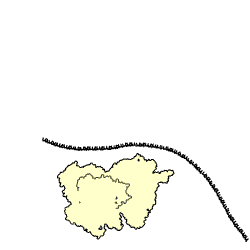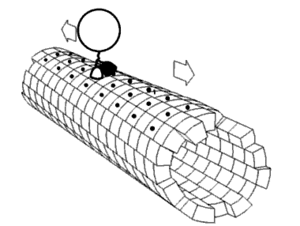Molecular biophysics
Molecular biophysics is a rapidly evolving interdisciplinary area of research that combines concepts in physics, chemistry, engineering, mathematics and biology.The discipline has required development of specialized equipment and procedures capable of imaging and manipulating minute living structures, as well as novel experimental approaches.Conformational change in structure can be measured using techniques such as dual polarisation interferometry, circular dichroism, SAXS and SANS.Direct manipulation of molecules using optical tweezers or AFM, can also be used to monitor biological events where forces and distances are at the nanoscale.Molecular biophysicists often consider complex biological events as systems of interacting entities which can be understood e.g. through statistical mechanics, thermodynamics and chemical kinetics.Axonemal dynein, found in cilia and flagella, is crucial to cell motility, for example in spermatozoa, and fluid transport, for example in trachea.Some biological machines are motor proteins, such as myosin, which is responsible for muscle contraction, kinesin, which moves cargo inside cells away from the nucleus along microtubules, and dynein, which moves cargo inside cells towards the nucleus and produces the axonemal beating of motile cilia and flagella.In general terms, a motor is a device that consumes energy in one form and converts it into motion or mechanical work; for example, many protein-based molecular motors harness the chemical free energy released by the hydrolysis of ATP in order to perform mechanical work.[17] Each protein exists as an unfolded polypeptide or random coil when translated from a sequence of mRNA to a linear chain of amino acids.Amino acids interact with each other to produce a well-defined three-dimensional structure, the folded protein (the right-hand side of the figure), known as the native state.


ribosomebiological machineprotein dynamicsphysicschemistryengineeringmathematicsbiologybiomolecularsupramolecularvirusesallosteric interactionsBrownian motioncable theoryOutline of Biophysicsbiochemistrymolecular biologyprotein biosynthesisFluorescentelectron microscopyX-ray crystallographyNMR spectroscopyatomic force microscopysmall-angle scatteringX-raysneutronsneutron spin echoConformational changedual polarisation interferometrycircular dichroismoptical tweezersnanoscalestatistical mechanicsthermodynamicschemical kineticsmoleculesComputational biologyapplied mathematicsstatisticsbiophysicsgeneticsgenomicscomputer scienceevolutioncomputational chemistrydrug designmaterials scienceMembrane biophysicsbiological membranecomputationalbiophysical methodsphase diagramsthermodynamiclipid raftMotor proteinsKinesinmicrotubulenanoscalesmolecular motorshydrolysismusclemyosinactive transportproteinsvesiclescytoplasmKinesinsaxonal transportspindle apparatuschromosomesmitosismeiosisflagellacell motilityspermatozoanucleusmicrotubulesdyneinFlexible linkersallosteryATP synthaseproton gradients across membranesgene expressionDNA polymerasesRNA polymerasesspliceosomeintronssynthesising proteinsnanoscale dynamicsmolecular machinesmechanical workproteinfree energyRichard Feynmannanomedicinebiological machinesAlbert Hibbsswallow the doctorThere's Plenty of Room at the BottomMolecular nanotechnologyspeculativemolecular assemblersnanorobotsProtein foldingphysical processnative3-dimensionalconformationpolypeptidethree-dimensional structurerandom coiltranslatedamino acidsnative stateAnfinsen's dogmaStructural biologycryogenic electron microscopyProtein structure predictionamino acidfoldingsecondarytertiary structureprimary structureprotein designbioinformaticstheoretical chemistry